-
Posts
2,792 -
Joined
-
Last visited
Content Type
Profiles
Forums
Gallery
Events
Articles
Posts posted by bill
-
-
1894 Aluminum
Electric Tower - Mechanics Art Building So-Called Dollar
Hibler & Kappen 252
38.5 mm EF
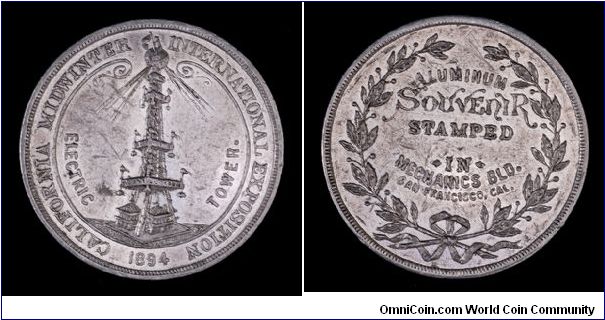
Obverse: Electric Tower, CALIFORNIA MIDWINTER INTERNATIONAL EXPOSITION / 1894. Inner inscription, ELECTRIC TOWER.
Reverse: Wreath, ALUMINUM / SOUVENIR / STAMPED / IN / MECHANICS BLD. / SAN FRANCISCO, CAL.
The version of the Electric Tower on this medal is the same as that on Hibler & Kappen 246 pictured above. Compare it to the previous post and you can see the differences. What is interesting are the doo-dads hanging off the various platforms. They do not show in actual pictures of the Electric Tower. Of addition interest on this medal is a small person on top of the tower seemingly planting a flag. I have no idea what it might represent.
Hibler and Kappen indicate that most of the medals sold at the exposition were struck in the Mechanics Art Building. This is one of two medals indicating that it was struck in the building.
The medal is a good example of the frustration of collecting aluminum. The surfaces exhibit near uncirculated luster, yet it has so many dings and marks that it has clearly been manhandled over the years, perhaps bouncing around in a drawer.
-
1894 Aluminum
Electric Tower - State Seal So-Called Dollar
Hibler & Kappen 249
38 mm AU
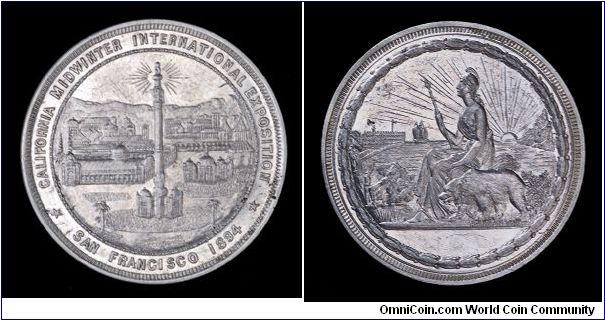
Obverse: View of the Electrical Tower and exposition buildings with the inscription: CALIFORNIA MIDWINTER INERNATIONAL EXPOSITION / SAN FRANCISCO 1894.
Reverse: California state seal with the sun setting in the Golden Gate in the background. A working miner is to the left of Minerva's feet. The signature HANSON CHI runs along the base of the seal on the right.
Hibler and Kappen note the medal is common holed for suspension, but rare without a hole. The piece pictured here was the second, and the nicer, of two unholed medals offered on Ebay at the same time.
The piece seems to have been designed from artist's preliminary sketches of the fair plans or a fanciful sketch as the details of the tower do not match the actual structure (see the other medals listed in this topic). The buildings, although somewhat related to the actual buildings, do not match any actual views of the fair. The seal has also been adapted to match the location of the exposition. Instead of the Sierra Nevadas in the distance, the Golden Gate and setting sun form the background of the medal's version of the seal. I'm assuming this medal was produced in Chicago with minimal knowledge of the local environment.
The 1849 version of the California State Seal:
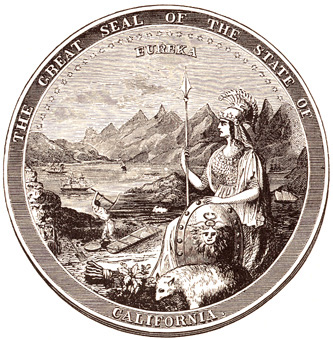
-
Hehe. I'm old and I've collected a long time...


-
An the reverse view on the 50 d. is beautiful. Wonderful note.
-
Sounds like notgeld. Se a couple of examples in this post:
-
I find the stories that go behind these notes fascinating. They make a nice and reasonably priced collection.
I agree and really enjoy seeing the new additions to your collection. Thank you for sharing and I look forward to your future posts.
-
As I've said before, I believe there are some coins that should be slabbed (or otherwise similarly protected such as in Capitol holders where they can be easily accessed) because of their quality and historical value. That being said, none of those coins are what any of us here typically think of as being collectible. We all might like to own or handle an 1804 silver dollar, but thats not going to happen. Now it just so happens that I got to hold an 1804 silver dollar (among many other rarities) during the Garrett auction preview days, but it was in a Capital holder. I don't think I would have had that opportunity otherwise.
As for buying collectible coins, raw is my preference (I actually own zero slabbed coins).
-
Denier, Vendome
Jean II
1202-1207
Legros 1239
Roberts 5123
Duplessy 545v
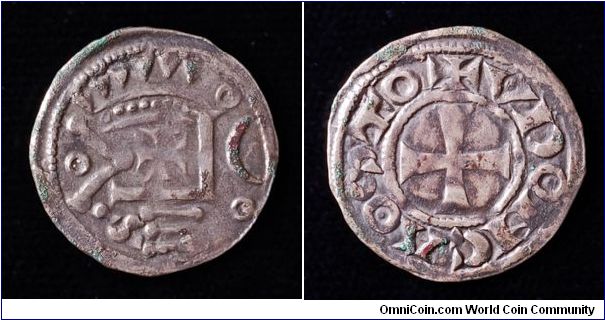
Vendome's earliest Tete Chinoaise style deniers are clearly based on those of Blois or at least inspired by them. Count Bouchard the Worthy (958-1012) was allied with Hugues Capet and that may help explain the influence of Blois, although Vendome exercised its own independence. Their coinage was more likely that of Anjou for much of the 1100s explaining an apparent lack of coinage between ca. 1065 and 1150. Vendome is caught up in the battles between the English and the Capetians over the next 50 years. Local coins are produced, but they are extremely rare. Vendome emerges with some stability under the Capetians by 1200.
Deniers of the type shown here are attributed to Jean II (1202-1207). There are multiple varieties of this type, likely indicating a production period greater than that of Jean II or a reinvigorated economy and montary production. These are most common of the Vendome deniers (although I have managed to acquire onlly one in the past few years).
The coins of Vendome are the subject of a book by Bernard Diry, Vendome: monnaies & tresors.
Some speculate the crescent in front of the face relates to a marriage alliance between Vendome and Chateaudun some years earlier (Jean II's grandmother? was from Chateaudun). I'll attempt to link up some of the symbols when I post my Chateaudun series. The coins of Jean III include the lily, likely reflecting the alliegence to the Capetian crown.
-
1894 Aluminum
Electric Tower So-Called Dollar
Hibler & Kappen 246
40 mm EF
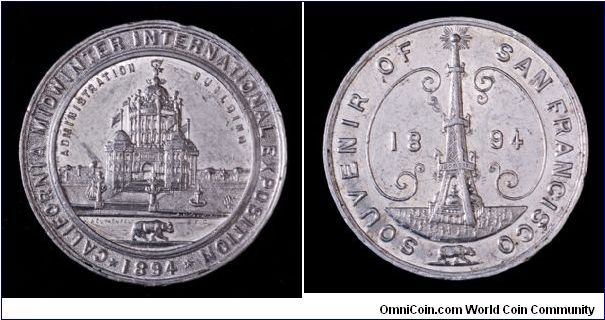
Obverse: Building facade, CALIFORNIA MIDWINTER INTERNATIONAL EXPOSITION / 1894 / ADMINISTRATION BUILDING / A HYLEN CHI. / BLUMENFELD S.F.C.
Reverse: Light tower, SOUVENIR OF SAN FRANCISCO / 1894.
I'm assuming this piece was designed by Blumenfeld of the San Francisco Chronicle, hence the name and letters in the field. I need to do more research to confirm this assumption. It is also signed A Hylen, Chicago along the ground line of the central design. I have another early aluminum medal from Chicago with the same A. Hylen Chicago mark. I'm assuming SFC stands for the Chronicle give the publisher's involvement in creating the exposition.
12/31/06 - Blumenfeld also designed medals for the World's Columbian Exposition and they are signed Blumenfeld P.O.C., so does anyone know what the initials might mean?
The electric tower stood at the center of the courtyard (the Court of Honor) and was San Francisco's la petite Tour Eiffel. The Belvista Cafe was on the first landing and one could ride an electric elevator to that 91 foot landing or two others at 147 and 210 feet. At the top, 272 feet, was a powerful electric search light that could be seen for miles. A novelty in a city where few had even seen an electric light bulb let alone contemplate having electricity in their homes.
The Online Archives of California have several interesting photographs of the tower by day and night:
http://content.cdlib.org/ark:/13030/tf8z09p6r4/hi-res
http://content.cdlib.org/ark:/13030/tf9x0nc0nr/hi-res
-
1894 Aluminum
Administration Building So-Called Dollar
Hibler & Kappen 258
44 mm EF
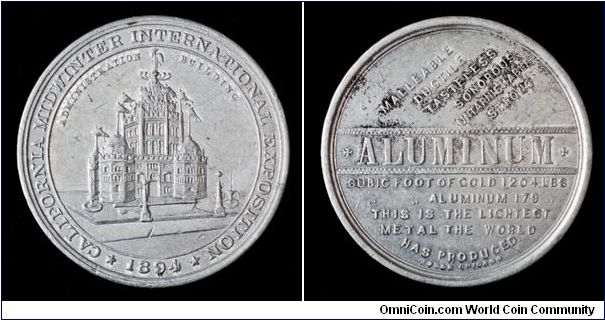
Obverse: Building, ADMINISTRATION BUILDING above. Inscription: CALIFORNIA MIDWINTERINTERNATIONAL EXPOSITION / 1894
Reverse: ALUMINUM across the center, above: MALLEABLE / DUCTILE / TASTELESS / SONOROUS / UNTARNISHABLE / STRONG, below: CUBIC FOOT OF GOLD 1204 LBS / ALUMINUM 179. / THIS IS THE LIGHTEST / METAL THE WORLD / HAS PRODUCED / NOBLE CHICAGO
Another Noble product sharing the same reverse design as the Bird's Eye View piece. The wedding cake architecture of the Administration Building combined styles from Siam and India, over the top even for San Francisco. It was built for $32,000 dollars and featured a 50 foot diameter gold-leaf dome.
An official fair photograph from the University of California's Online Archive of California can be seen at:
-
The Chicago World's Columbian Exposition was so successful that San Francisco Chronicle publisher and Columbian Exposition director, Michael de Young, sought to bring the exposition west. His goal was to showcase the city and improve the local economy. Funded solely by donations, they broke ground on August 24, 1893 and opened 26 days late on January 27, 1894.
1894 Aluminum
Bird's Eye View So-Called Dollar
Hibler & Kappen 259
44.5 mm BU
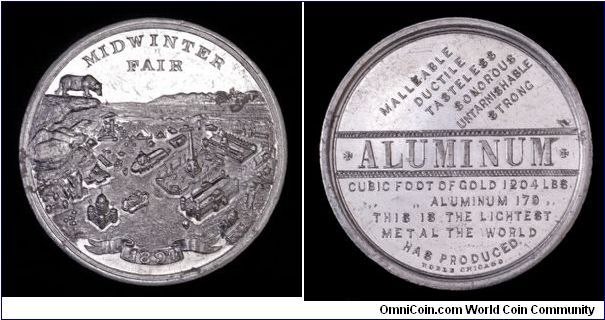
Obverse: Bird’s eye view of fair, MIDWINTER FAIR / 1894.
Reverse: MALLEABLE / DUCTILE / TASTELESS / SONOROUS / UNTARNISHABLE / STRONG / ALUMINUM / CUBIC FOOT OF GOLD 1204 LBS. ‘/ ALUMINUM 179 / THIS IS THE LIGHTEST / METAL THE WORLD / HAS PRODUCED / NOBLE CHICAGO
The central courtyard of the fair remains today in San Francisco's Golden Gate Park as the home of its museums. The Japanese Tea Garden built for the fair (upper left corner of the grounds below the bear's tail) still stands as a park attraction. I suppose the bear is standing on an exagerated Strawberry Hill in this stylized bird's eye view.
This 1892 view of the park from SF archives shows the general state park development prior to the fair.

The view is looking west. The medal's view of the exposition grounds is looking northwest towards the Golden Gate. The grounds were situated just before Strawberry Hill (the peak in the park view) and the central courtyard ran to the northeast.
This particular medal is rare and rarely encountered in this state of preservation. It was struck by Noble of Chicago. The novelty and promotion of aluminum was still in full swing.
-
1893 Aluminum
Ferris Wheel So-Called Dollar
Hibler & Kappen 170
45 mm EF
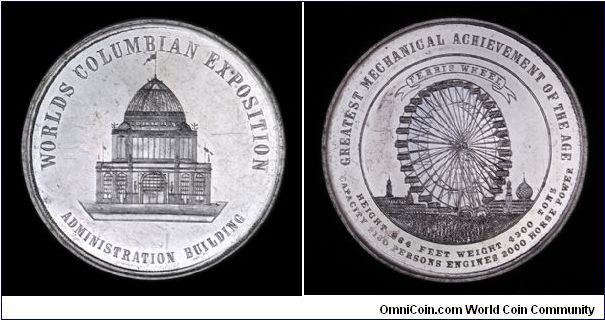
Obverse features the Administration Building facade and the inscription, WORLDS COLUMBIAN EXPOSITION / ADMINISTRATION BUILDING.
Reverse features the Ferris wheel with the Midway backdrop and a crowd of people in the foreground with the inscription, GREATEST MECHANICAL ACHIEVEMENT OF THE AGE / HEIGHT 264 FEET WEIGHT 4300 TONS / CAPACITY 2160 PERSONS ENGINES 2000 HORSEPOWER / FERRIS WHEEL.
With almost 2200 people on a full ride, it must have been an amazing trip. The view from the top of the Ferris Wheel:
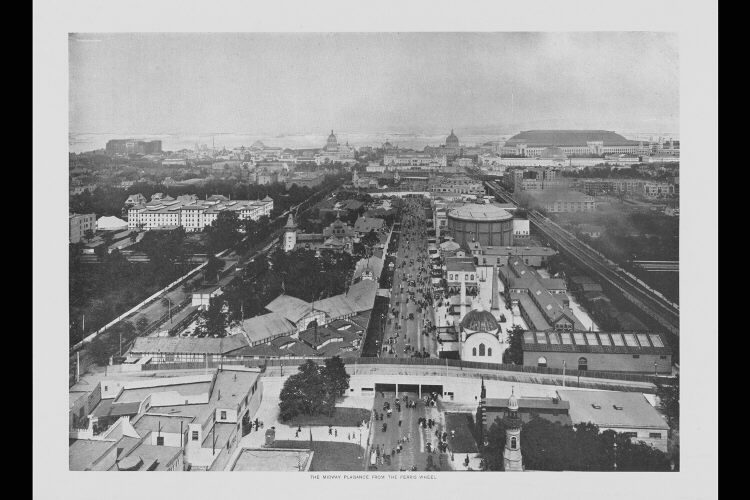
The Administration Building:
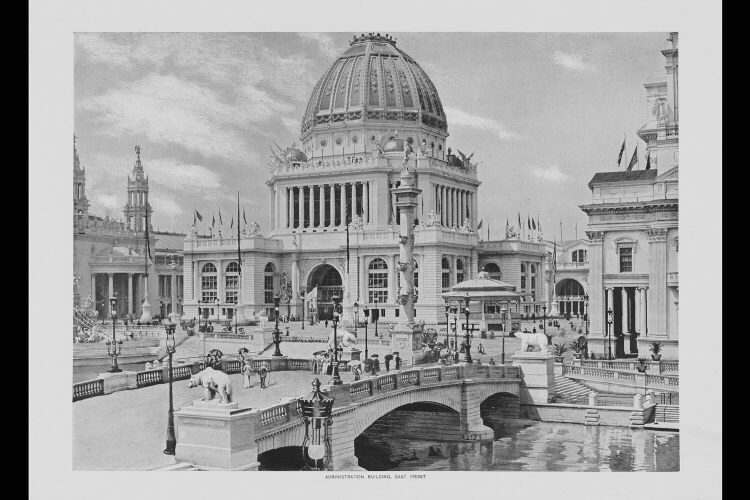
-
Technically, its not a NSDAP election token, but it sets the stage for the political environment in Weimar Germany. The horrific inflation of the early 1920s destroyed people's lives and helped fuel the political furor that led to the appeal of radical political parties. I believe the following token may have been a socialist token, but it does not matter. The sentiment spoke for most of the parties.
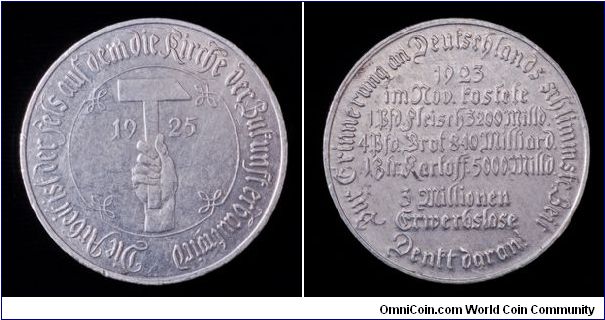
Obverse: Raised hand grasping hammer. Die Arbeit ist der Fels auf dem die Kirche der Zurkunft erbaut wird.
Work is the rock on which the church of the future is built.
Reverse: Zur Erinnerung an Deutschlands schlimmste Zeit / 1923 / im Nov. kostete / 1 Pfd. Fleisch 3200 Milld. / 4 Pfd. Brot 840 Milliard. / 1 Klr, Kartoff. 5000 Milld. / 3 Millionen / Erwerbslose / Denkt daran!
To the memory of Germany’s worst time. 1923 in November, Prices:
1 pound of meat, 3200 Million marks
4 pounds of bread, 840 Million marks
1 kiloliter? potato, 5000 Million marks
3 million unemployed, Remember!
Sometimes its helpful to remember the economic reality that the colorful notgeld represents.
-
Thats a real catchy design.
 One question, chaining a dove to a rock I'm assuming for traning the falcon? And she was a falconer?
One question, chaining a dove to a rock I'm assuming for traning the falcon? And she was a falconer?
Uh, I believe that image is allegorical and refers to her execution (the rock has the date of her execution on it).
-
Obol, Blois
Hugues de Chatillon
1292 - 1307
Legros 992
Roberts 5065s
Duplessy 591

After a 100 year lapse, coinage began again in Blois under Jean de Chatillon (1241-1279). Most likely, the Capétien-Plantagenêts conflict that heavily impacted the Chartrain played a role in the demise of some coinage. While the lands of Champagne yielded to the crown in the 1200s, followed by those of the Chartrain and Chartres to relieve debts, the lands of Blois and Dunois preserved their independence until Louis XII became king in 1498 when Blois becomes the royal residence of Louis.
Jean Châtillon reunited the lands of Chartres and Blois in 1256. His son, Hugues, struck the obol pictured here. The lily pays hommage to the ties to the royal French line. All coins from the late period of the history of Blois are rare.
Despite the poor preservation of this particular coin, one can still see the improved technique and quality of the die engravers.
-
Denier, Celles
Robert I
1178 - 1189
Legros 1442
Roberts 5033
Duplessy 611A
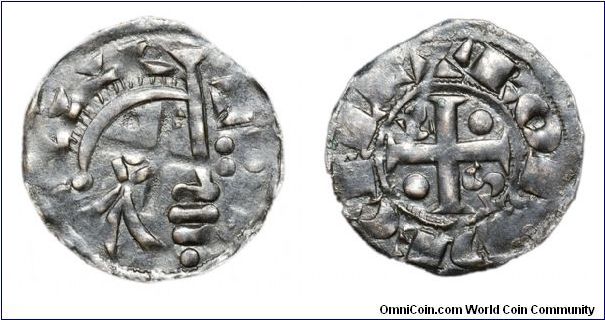
The lords of Celles were vassals of Saint-Aignan (in turn vassals of Blois). What I find interesting is that their die cutters copied the earlier style of Eudes II at a time when the mint at Saint-Aignan was copying those of Chartres and Châteaudun. Both mints converted to the emerging castle (châtel-tournois) style that replaced the tête chartrain. I particularly like the unique lettering style on the reverse. As with the coins of each of the minor mints, all Celles coins are rare.
-
Denier, Saint-Aignan
Geoffroy I of Donzy
996 - 1037 (coinage likely dates ca 1030 to 1175)
Legros 1461
Roberts 5147
Dupplesy 608
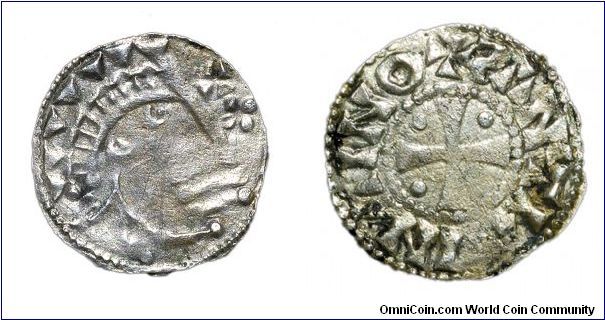
The lords of Donzy were vassals of the Counts of Blois. The earliest examples of their coins date to the first quarter of the 11th century. All varieties of the basic type shown here are rare. Compare the basic style of this piece with that of Eudes II above. Either the mints shared the same die cutters, or the artists closely copied the Blois style. When the Blois mint ceased production, the coins of Saint-Aignan changed to the style of Chartres and Châteaudun. Compare this to the next coin of Celles that maintains the blésoise style head.
-
Denier, Blois
Thibaut III
1037 -1089/90
Legros 965
Roberts 5056
Duplessy 578
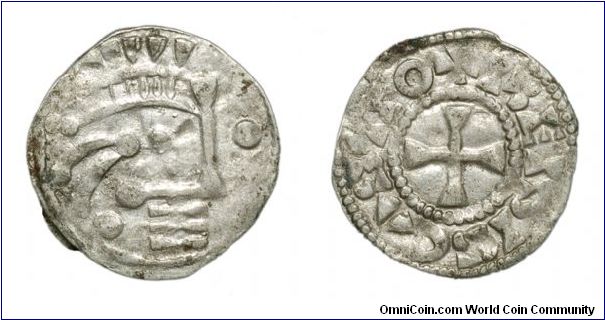
The first tete chinonaise I acquired in 2002 from Pegasi.
In April of 2006, I acquired this unlisted variety from Pegasi. (Note two dots or bezants on the obverse to the left of the three bars forming the mouth and chin instead of the one in the type example. The reverse inscription is partially blundered and lacking the cross that typically marks the top of the design and begins the legend.)
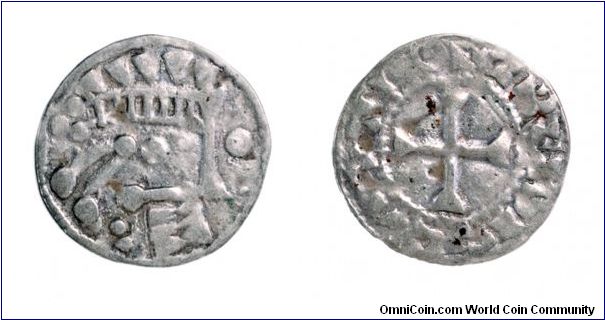
Thibaut III was unable to sustain the gains of his father, losing territory through inheritence practices and continued battles with the likes of Count Geoffrey Martel of Anjou. The loss of Touraine in 1044 ended the expansionist goals of the House of Blois.
Approximately 100 years passed after ca. 1100 before coinage would resume in Blois.
-
Denier, Blois
Eudes II
ca. 996 - 1037
Legros 943
Roberts 5055v
Duplessy 575
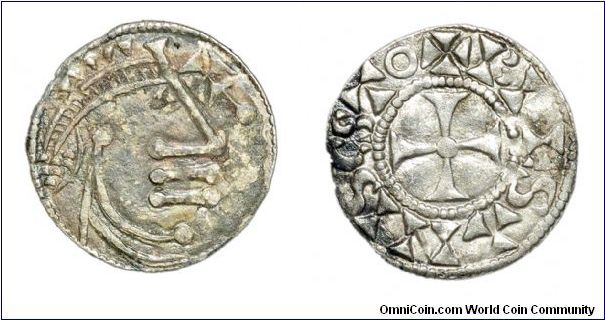
Eudes II seized the counties of Troyes and Meaux after 1019. He acquired Champagne in 1023 and succeeded in encircling the lands of the Capétians. In 1032, he acquired the kingdom of Burgundy. When he died in 1037, the lands were divided among his descendants.
-

Roger Burdette's Renaissance of American Coinage: 1905-1908 arrived today, the second of three planned volumes. The third volume appeared first, this is the first volume published second, the second volume comes next year. 1905 to 1908 covers the Augustus Saint-Gaudens designs and a briefer discussion of the Pratt designs. Burdette's work is fresh and provides new insights to our coinage and the politics behind their design and production.
-
When you have the Caroline in hand, and it's less than an inch across, you are left wondering how the engravers of the time with their relatively primitive equipment could produce such masterpieces. The photograph doesn't do this medal justice. There's a subtle toning that I can't seem to capture. I've tried the angled glass technique but then I find I lose the actual color of the field. With the current technique I'm using I get the color but lose the toning, the pics seem a bit flat for lack of a better word.
I suspected something like that from the photograph. It gives me that sense that its spectacular and the picture doesn't quite catch it. I've taken to snapping two images, one with the axial ligthing through the angled glass, then a send with direct light, but leaving the glass in place so there is no movement. I then process each image in Photoshop to try to capture the best elements of that partuclar lighting technique. Finally, I overlay one with the other (generally the darker image as the base) and tinker with the opacity of the top image to get the best possible image. Sometimes it works. I have no qualm about toying with hue, saturation, etc to try to get the characteristics to emerge that I want to capture. Sometimes its easy. Other pieces just seem bound and determined to withhold their beauty from a mere mortal photographer such as myself.
-
1808 La Reine de Naples, France
Laskey CXL
Bramsen 772
d'Essling 2543
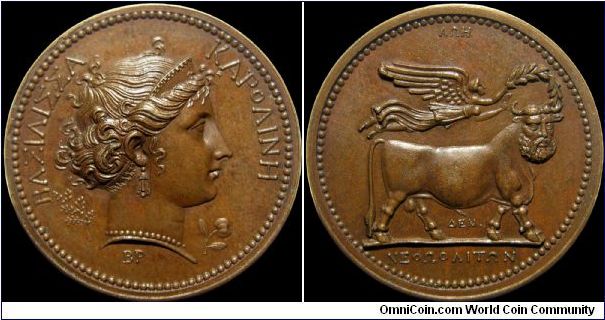
22mm Link
In 1808 and later in 1813 there were a series of medal mint visitation medals produced featuring Napoleon's sisters, wife and step-daughter. I've called the series "The Ladies".

Your collection is truly exceptional, but there are pieces that stand out for each of us because of personal likes, dislikes, etc. I love the style and themes of this particular medal. You have been very careful to note originals and restrikes. I am struck by the beautiful preservation state of this medal. I know your pieces are of high quality and your photography is exceptional, but even so, I get the feeling that this must be a stunning piece that must be even better in person. I'm not sure how to phrase my question. Can you comment on the quality of this particular medal. Is it unusual for the series, the type, your collection, etc? Does it look good in the photograph but is in fact not exceptional? Do you know much of its history and how it survived in its current state?
-
1893 Aluminum
Ferris Wheel So-Called Dollar
Hibler & Kappen 171
38.5 mm EF
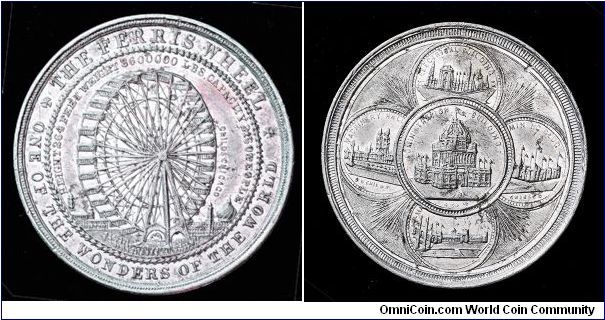
Obverse features the Ferris Wheel created for the fair, Chicago's answer to the Eiffel Tower. The legends around the wheel read CHILDS CHICAGO,around HEIGHT 264 FEET WEIGHT 8600000 LBS. CAPACITY 2160 PEOPLE, outer inscription THE FERRIS WHEEL / ONE OF THE WONDERS OF THE WORLD.
The reverse features minature Exposition building medals with minature CHILDS signatures. The medals include: ADMINISTRATION BUILDING / MACHINERY HALL/ ELECTRICAL BUILDING / MINING BLDG / S D CHILDS & CO CHICAGO.
The Ferris Wheel was the focal point of the Midway Plaisance (the postcard and hamburger were other notable introductions to our culture at the fair). The ethnographic displays and villages were supposed to be educational, but the were the popular entertainment of the fair, including the the Egyptian 'hootchy-kootchy' dancers.
An interactive map of the Midway can be found at http://columbus.iit.edu/dreamcity/midway.html.

-
1893 Aluminum
Chicago 60th Anniversary Souvenir
Eglit 42
44.5 mm Unc
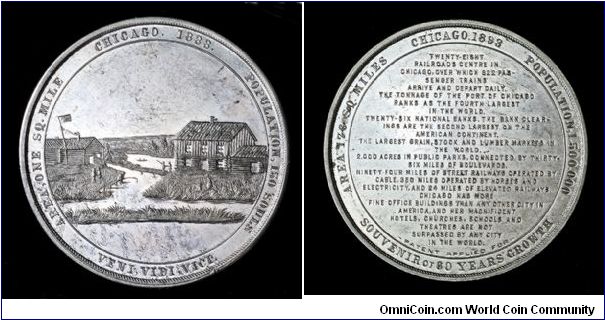
The obverse shows a two log cabins and a fishing scene, a man sitting on the dock with a pole, two on a catwalk with a pole, and a boat further out in the channel. The inscription reads, AREA, ONE SQ. MILE CHICAGO 1833. POPULATION, 150 SOULS / VENI, VIDI, VICI.
The reverse is an early attempt at the Lord's Prayer on the head of a pin. Hibler & Kappen list one Chicago Facts so-called dollar with minimal facts, but they don't include this piece although it falls within their size limits. This piece reads on the outer ring, AREA 176 SQ. MILES CHICAGO.1893 POPULATION, 1.500.000 / SOUVENIR OF 60 YEARS GROWTH. Interior inscription, TWENTY-EIGHT / RAILROADS CENTRE IN / CHICAGO, OVER WHICH 922 PAS- / SENGER TRAINS / ARRIVE AND DEPART DAILY. / THE TONNAGE OF THE PORT OF CHICAGO / RANKS AS THE FOURTH LARGEST / IN THE WORLD. / TWENTY-SIX NATIONAL BANKS. THE BANK CLEAR- / INGS ARE THE SECOND LARGEST ON THE / AMERICAN CONTINENT. / THE LARGEST GRAIN, STOCK AND LUMBER MARKETS IN / THE WORLD. / 2,000 ACRES IN PUBLIC PARKS, CONNECTED BY THIRTY- / SIX MILES OF BOULEVARDS. / NINETY-FOUR MILES OF STREET RAILWAYS OPERATED BY / CABLE, 350 MILES OPERATED BY HORSES AND / ELECTRICITY, AND 24 MILES OF ELEVATED RAILWAYS. / CHICAGO HAS MORE / FINE OFFICE BUILDINGS THAN ANY OTHER CITY IN / AMERICA, AND HER MAGNIFICENT / HOTELS, CHRUCHES, SCHOOLS AND / THEATRES ARE NOT / SURPASSED BY ANY CITY / IN THE WORLD. / - PATENT APPLIED FOR -. Whew, and all in just 60 years!
The Chicago Public Library features vignettes of Chicago history. Legislation passed February 12, 1831 provided that any community of over 150 inhabitants was authorized to incorporate as a town, with limits not to exceed one square mile in extent. On August 12, 1833, the Town of Chicago was incorporated with a population of 350. Chicago grew up around Fort Dearborn. Five or six log houses were located outside the fort, presumably a couple of them are shown on the medal although I do not know the source of the illustration. The Chicago Public Library shows an image, A Map of Chicago, Incorporated as a Town, August 5, 1833, compiled from the original
"Map of Chicago about 1833," by Walter H. Conley and O.E. Stelzer, 1933. (CCW Oversize 44). Although the image is small, you can just makes out some scenes that may have inspired the artist.



World's Columbian Exposition 1892-93
in Exonumia Virtual Museum
Posted
1892 Aluminum
World Globe So-Called Dollar
Hibler & Kappen 174 Thick
42.5 mm AU
Obverse: Bird's eye view of the fair superimposed on a globe with the inscription, WORLD'S COLUMBIAN EXPOSITION / CHICAGO. 1892-3. The outer ring reads, WORLD'S-FAIR / SOUVENIR.
Reverse: Scene of Columbus landing superimposed on a globe with the inscription, LANDING OF COLUMBUS IN AMERICA / OCTOBER 12TH 1492. The outer ring reads, PAT'D DEC. 1, 1891.
The globes are definitely raised above the rim on these medals creating the sense of an actual globe. For those of you who have noted my birthday, you will understand the significance of the October 12th date. (Damn that Richard Nixon. He signed the bill to make Columbus day a three day weekend, thus ignoring the real date of historical significance. )
)
Bancroft's Book of the Fair offers a contemporary bird's eye view similar to that of the medal:
This medal seems to be one of the more common medals of the fair, including in higher grades. I've passed a number of these before settling on this piece from Ebay. The next step is a graded, encapsulated medal. I haven't taken that step as yet since I would be tempted to release the critter back into the wild.